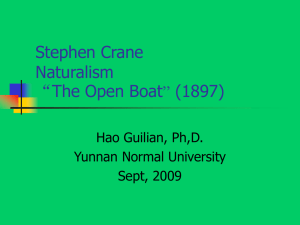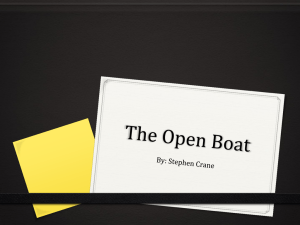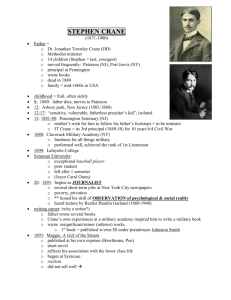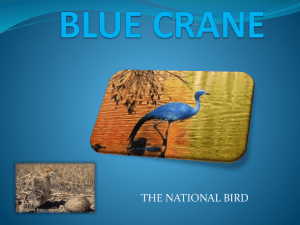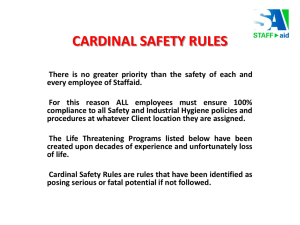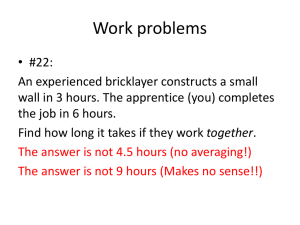the captain - Miss Thompson Media
advertisement
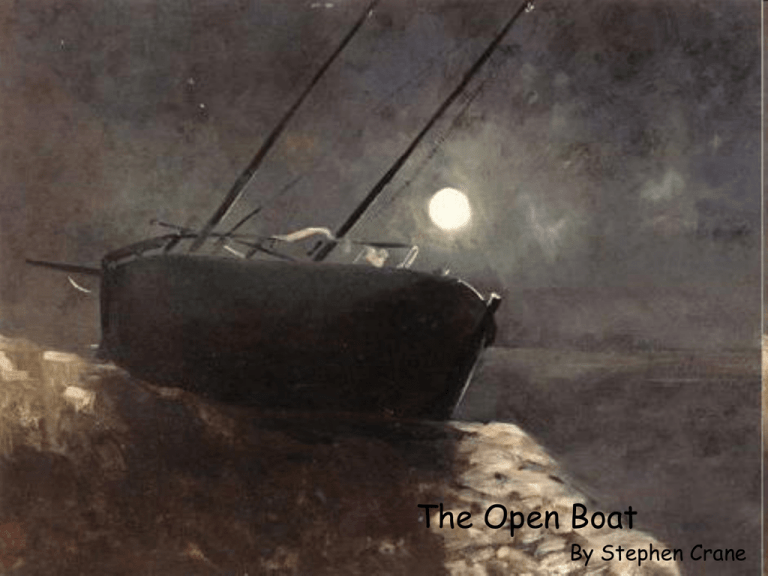
The Open Boat By Stephen Crane Author’s background Stephen Crane born November 1, 1871-June 5, 1900 He spent much time studying science and literature but he didn't attend school until he was eight years old. However, when he did, he did two years' worth of schoolwork in just six weeks. (=O wow ) As a teenager, he enjoyed making up words and writing essays and often wrote many articles with the help of his brother and he collected information for his mother, who wrote journals for the Methodist Church. Stephen Crane changed from many different schools in his life, finally when he had enrolled at Syracuse University, there were too many distractions at school and in town for him to concentrate on his studies, so in 1891, at the age of twenty, he left the university without completing a degree. Later on, he accepted a position with the Bachelor-Johnson Syndicate working as a war correspondent. Crane was sent to Cuba to cover a developing conflict between Cuba and Spain. The ship, Commodore, on which he set out for Cuba, had serious structural damage after running aground and sank. Crane's escape from the sinking ship by rowboat took a great physical toll on him, the experience inspired him with the basis for the short story, "The Open Boat”. Plot Summary "The Open Boat" is divided into seven sections, each of which is told mainly from the point of view of the correspondent, who is Stephen Crane himself. The story begins with a description of men aboard a small boat on a rough sea. The first part of the story introduces the four characters—the correspondent, an observer from the rest of the group; the captain, who is injured and lies in the bottom of the boat.; the cook, who is fat but optimistic that they will be rescue is bailing water out of the bottom of the boat. The cook is the most talkative of the four; and the oiler, Billie Higgins, who is physically the strongest, as well as the only one who is named throughout the story. The four have survived a shipwreck, which occurred before the beginning of the story, and are drifting at sea in a small boat the size of a bathtub. This section features character development and many descriptive passages depicting the tiny boat’s course across the rough waves. The captain doubts about their chances of survival, but then reassures the men that “we’ll get ashore all right.” Later on, the captain is the first to spot a barely visible lighthouse and they know they are approaching shore. The captain makes a sail using his overcoat and rows himself to give the oiler and correspondent a chance to rest.Unwilling to risk running the boat ashore in the rough surf, the men smoke cigars, drink from their water supply, and wait to be spotted by the lighthouse rescue crew. The lighthouse appears deserted. The men discuss rowing toward land and swimming through the surf once the boat capsizes in the rougher water closer to shore. When the oiler takes the boat toward shore, it quickly become apparent that the rougher waves will capsize their vessel when they are still much too far out to swim. The four men return to deeper but safer offshore water. Later on a current takes them away from the lighthouse, and they row towards “little dots which seemed to indicate a city on the shore.” The correspondent and the oiler take turns rowing so they each can have some time at rest. Someone is seen on the shore waving to them. Soon a crowd gathers, disembarking from a bus. The men realize that the people on shore are tourists who think they are fishermen or pleasure boaters. No one is helping them. The four men spend a cold night rowing steadily toward distant lights. While the correspondent is rowing alone, a large shark cruises in the surroundings of the boat. The predator is never named, but is described in terms of its shape, size, speed, and the sound of the fin slicing through the water. The crew all are afraid of drowning and dieing so they agonize privately over the injustice of their situation: “If I am going to be drowned. . . why. . . was I allowed to come thus far?” At dawn, the men decide that their only chance is to row toward the distant shore again and swim when the boat capsizes. The narrative stays primarily with the correspondent’s inner thoughts during this passage. He reflects that nature is malicious, desiring his death and is in fact perfectly indifferent to his fate. On the captain’s order, the oiler rows the boat directly toward shore. Waves crash into the boat as it enters the breakers. The cook briefly bails out water, and then the men abandon the boat filled with water that’s about to sink. The oiler swims strongly and steadily toward the shore. The cook, in his lifejacket and clutching an oar, floats along until the captain calls to him to turn over on his back; in that position he rows himself as if his large, bouyant body were a canoe. The correspondent clings to a piece of a lifejacket and paddles slowly, thinking of the vast distance he has yet to cross. The injured captain clings to the stern of the overturned boat, which is pushed toward the beach by the strong surf. A wave tosses the correspondent over the boat and into waist-deep water, but he is too weak to even stand up. Suddenly, a man appears on shore, stripping off his clothes and running into the water. The rescuer drags the cook to safety and then approaches the captain, who waves him away to help the correspondent first. Billie, the oiler, is face-down in the shallow water, dead. The three living men are fed and tended. That night they listen to the sound of the waves against the shore “and they felt that they could then be interpreters.” Tasks A & B A) Pairs complete the following: Student A = odd pages Student B = even pages 1. Adjectives = ‘A’ 2. Metaphor = ‘M’ 3. Simile = ‘S’ 4. Personification = ‘P’ B) Identify techniques used to describe these 3 aspects of the story. i) Characters– Correspondent; Oiler; Cook; Captain ii) The sea / waves iii) The boat SETTING Find evidence to support the following assertions about the setting: 1. Set on a 10 foot dinghy which is floating upon a rowdy ocean near the coast of Florida 2. Set in the late 1800s Crane uses the setting to show the relationship between humans and nature : "None of them knew the colour of the sky … and all of the men knew the colours of the sea“ He implies that the men in the dinghy are so overwhelmed by the power of nature that they cannot see the colour of the sky. He also suggests that nature is unpredictable and the men are uncertain of their fates. Find two more examples of this relationship and explain then. -"Their back- bones had become thoroughly used to balancing in the boat and they now rode this wild colt of a dinghy like circus men“ Crane uses this description to portray the chaos of the sea and the idea that the men have slightly adapted to some of nature's ways in order to survive. -Crane's descriptions of the sea show nature's lack of concern for their tragedy: "The birds sat comfortably in groups, and they were envied by some in the dinghy, for the wrath of the sea was no more to them than it was to a covey of prairie chickens a thousand miles inland". -When a tower is sited on a nearby island, Crane describes it as a: "giant, standing with its back to the plight of the ants", the ants obviously represent nature and the tower is seen as the power of humanity. It represents freedom, hope, and a win against nature Crane includes many living figures in his short story. It is, however, mainly based on the four men who survived the shipwreck of their ship Commodre. Characters Correspondent The four men consist of: Captain Cook and Dingy Oiler The Correspondent The Captain The Oiler The Cook Other minor figures involves the people at the beach who rescues the stranded men. The seagulls which are hated by the sailors but shows the men are close to land. The shark which represents danger and awareness. The “sea babes” are mythical sea creatures of which sailors back in that time period believed in their existence. Task: Characters Correspondent Provide a detailed description of each of the characters in the boat. i) The correspondent ii) The oiler Captain Cook and Dingy Oiler iii) The cook iv) The captain Use supporting quotes and examples, explain their characteristics and role in the story. How might the characters link to the themes in the story or what other purpose? The Correspondent: -Story is mainly written from his perspective. He represents the author and retells the story of Stephen Crane’s shipwreck. -well educated man. He is addressed by the oiler as “sir” -The correspondent is friends with the three other men. Stephen Crane describes their relationship as “..they were friends – friends in a more curiously ironbound degree than may be common” -He is especially closely bonded to the oiler. “They sat together in the same seat, and each rowed an oar” -he wears a drenched “coat” of which he finds cigars – he smokes -The correspondent accepts the situation he is in. He does not mind dying “I am going to drown? Can it be possible?” He doesn’t moan or groan for the misfortune of being stranded in the sea (he sees it rather positively as being fortunate to survive the shipwreck) -Inexperienced. “The correspondent was at the oars then and for some reason he too were important” -He could be left handed “his pale left hand was upon his chest..to thrawt the going of his life” -Has an inner fear as shown with his experience alone with the shark. The Oiler -Billie -Oiler is the man who oils the engine of the ship. -He is one of the dingy’s oarsmen along with the correspondent -Billie is a confident swimmer “[he] was ahead in the race. He was swimming strongly and rapidly” -He strives to survive as the men and their dingy fight against nature. The correspondent questions him “Did you ever like to row, Billie?” and Billie replys “No” but he does it anyway as he is determined to reach land safely. -The oiler obeyed the orders of the captain without doubt. -The oiler is the experienced men. He does a lot of steering. -Billie drowns at the end of the story and dies “but a still and dripping shape was carried slowly up the beath, and the land’s welcome for it..sinister hispitality of the grave” – same as the real life situation which happened to Stephen Crane; the oiler (Billie) is drowned to death. Captain -Injured “his captain was handing with his one good hand” -He is like the mother figure in this short story. He looks after his boys and instructs them what to do “soothing his children” -He is depressed about the shipwreck and the death of seven of his crews “captain had on him the stern impression of a scene in the grays of dawn of seven turned faces” -the captain is respected by his men as every order is obeyed with no hesitation. -captain is considerate. He makes sure the oiler and the correspondent gets enough rest “give you two boys a chance to rest” “we’ll give those boys a chance to get into shape again” - “The patient captain” -has a strong will to survive. “the correspondent marveled that the captain could still hold to it” -sacraficial. “the captain waved him (rescuer) away and sent him to the correspondent” Cook -Physical descriptions of the cook includes “His sleeves were rolled over his fat forearms, and the two flaps of his unbuttoned vest dangled as he bent to bail out the boat” -enthusiastic “he murmured dreamfully” “said the cheerful cook” The Dingy -Much described as a human. Stephen Crane refers to the dingy with human characteristics. “The little boat turned her nose once more down the wind”. -The Captain shows concern for this dingy “Take her easy now” Note: The boat is given a feminine title as water transportations are know as “she” during the time period this short story was written. Four Themes main themes in this short story includes: 1. Individual vs Nature 2. Perspective 3. Death 4. Free Will – Existential crisis 1. Individual Vs. Nature During the late nineteenth century, Americans had believed that they could control and conquer their environment. With the technological breakthroughs of the Industrial Revolution, humankind appeared to have demonstrated its ability to both understand and to dominate the forces of nature. In “The Open Boat,” Crane questions these self-confident assumptions by describing the precarious situation of four shipwrecked men as they are tossed about on the sea. The men seem to recognize that they are helpless in the face of nature. Their lives could be lost at any moment by the most common of natural phenomena: a wave, a current, the wind, a shark, or even simple starvation and exposure. In a passage that drips with irony, Crane writes of the correspondent: “He thought: ‘Am I going to drown? Can it be possible? Can it be possible? Can it be possible?’ Perhaps an individual must consider his own death to be the final phenomenon of nature.” This passage suggests the absurdity of an individual’s sense of self-importance against the power of nature. 2. Perspective One of the main themes of the story is the perspective, or point of view. Crane’s famous first sentence of the story presents this theme immediately: “None of them knew the color of the sky.” The men in the boat are so focused on the danger presented to them by the waves that they are oblivious to all else. The story continually emphasizes the limitations of a single perspective. When the shipwrecked men are first spotted from the shore, they are mistaken for fishermen. The people on shore do not perceive their distress and only wave cheerfully to the men. Crane writes of the men in the boat that if they were viewed “from a balcony, the whole thing would doubtless have been weirdly picturesque.” This serene perspective contrasts markedly with the frightening and violent reality the men in the boat are experiencing. Crane’s point seems to be that humans can never fully comprehend the true quality of reality, but only their own limited view of it. Throughout the story, the situation of the men in the boat seems to them “absurd,” “preposterous,” and without any underlying reason or meaning. Yet once the three survivors are safely on shore at the end of the story, they believe that they can look back and “interpret” the import or meaning of what has happened to them. The reader is left to wonder whether anything can ever be truly understood, or if all understanding is simply an agreed-upon, limited perspective that provides the illusion of unity to the chaos of lived events. 3. Death The drama of the story comes from the men’s realization that they are likely to drown. Having to confront the probability of their own imminent death, each of the characters accepts what Crane calls a “new ignorance of the grave-edge.” It is interesting that Crane refers to this understanding as “ignorance” rather than “knowledge.” Being at the mercy of fate has demonstrated to them how wrong their previous beliefs about their own importance had been. The correspondent, in particular, is troubled by the senselessness of his predicament, and he thinks about a poem in which a French soldier dies, unceremoniously, far from his home and family. Facing senseless death, the universe suddenly seems deprived of the meaning he had previously attached to it. Thus, he is overtaken by a new “ignorance” about life, rather than a new “knowledge.” Crane seems to endorse the idea that nature is random and senseless by having the oiler drown in the surf. Of all the men, the oiler seemed the most likely to survive, being the most physically fit. His death implies that the others’ survival was merely the result of good fortune. Once the survivors are safe from danger, however, death’s senselessness is quickly forgotten. 4. Free Will Crane was regarded as a leading member of the Realist or Naturalist movement in his time. One of the main concerns of the Naturalists involved the dilemma of whether human beings could exercise control over their fate or whether their fate was predetermined by their environment. To state it differently, they asked whether humans possess a free will or were powerless to shape external events. Drawing upon deterministic philosophies such as those of Charles Darwin, Auguste Comte, or Karl Marx, the Naturalists analyzed the various natural forces that effected the “struggle for life.” These concerns are evident in “The Open Boat.” Although the four men are clearly making the best effort to get to shore, it is never certain until the end whether they will drown. Their fate seems to rest mostly in the hands of forces beyond their control. A prime example of this comes when the correspondent gets caught in a current while trying to swim to the shore. He is trapped by an invisible force — an underwater current — which he can neither understand nor escape. For unknown reasons, the current suddenly frees him and he is washed ashore by a giant wave. It seems clear that Crane attributes the correspondent’s survival more to uncontrollable forces than to his own efforts. Style Stylistically, critics note Crane's use of irony and praise his shifting perspective in the story. Tone may be characterized as serious or ironic, sad or happy, private or public, angry or affectionate, bitter or nostalgic, or any other attitudes and feelings that human beings experience in the story. Stephen Crane's story gives us an example of another kind of irony, in this case cosmic irony, which occurs when a writer uses God, destiny, fate, or some larger force to dash the hopes and expectations of a character or of humankind in general. Three specific examples of cosmic irony symbolism used by Crane are, the power of the ocean against the insignificance of the boat, the sea against the universe, and the little boat in a vast sea from the people on the shore. The story is told from the perspective of each of the crew members, as well as from the vintage point of an objective observers. Dialogues, in which different speakers are never identified. In these ways, the reader is given the sense that all of the crew members share similar feelings. Similar to other major works by Stephen Crane, "The Open Boat" contains various uses of imagery, metaphor and colour, combined with simple, clear writing. Humour also appears throughout, serving in stark opposition to the dreary setting and desperate characters. Glossary: Apropos- appropriate Opprobrious- Bringing disgrace Billows- A large wave or swell of water. Obstreperous- Noisily and stubbornly defiant. Myriads- Constituting a very large, indefinite number Cessation- A bringing or coming to an end Essay and exam questions Discuss how Crane presents the relationship between man and nature in the story, The Open Boat. How does Crane explore the idea of fate versus free will in his story? Crane reveals more ignorance about life and death, with than knowledge in his Compare The Fall of the House of Usher by Edgar story. Discuss. Allen Poe How it Happened by Arthur Conan Doyle Real Time by Amit Chaudhuri A person’s own views on reality can only ever be narrow and limited. Discuss in relation to The Open Boat.
